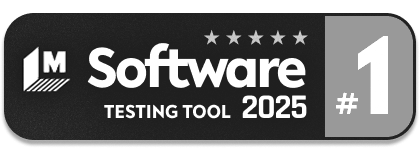testRigor vs. Testim
End-to-end test automation tends to be the most complex part of testing, but it doesn’t have to be. Choosing the right tool to match your objectives is one of the most important aspects of the test automation process. Let’s compare key features to see how testRigor measures up against Testim for your test automation requirements.
Why testRigor?
See our summary table and decide for yourself.
| Supported Features |

|
Testim
|
Insights |
|---|---|---|---|
| Generative AI-based test creation | You have the ability to generate entire automated tests based on test case titles using testRigor’s Generative AI engine. | ||
| Completely no-code test creation | Testim uses a record-and-playback method to write tests. This works well for simple tests, but for complex cases and customized validations, a programming language becomes necessary. With testRigor, even a manual tester can write test steps 15 times faster than with any other tool because it uses plain English for test authoring. | ||
| Ease of test creation from UI perspective | Creating a test in Testim requires a lot of clicking and user interaction with the editor, which is not a great user experience. testRigor offers a much more straightforward experience. | ||
| Ultra stable tests | To create scriptless tests, Testim uses record-and-playback, which can sometimes lead to fragile tests. Alternatively, testRigor tests are so stable that some users even use them for monitoring. | ||
| Email alerts for test failures | Both testRigor and Testim offer features for sending alerts about test failures with details. | ||
| Minimum maintenance overhead | With Testim, activating Smart locators can cause tests to miss potential visual bugs. However, deactivating them can lead to test failures from minor changes to the underlying code, which requires more maintenance. In contrast, testRigor users note spending up to 99.5% less time on test maintenance. | ||
| Test analytics | Both testRigor and Testim offer good reporting and test results trend features, making it easier for stakeholders to gather useful information and make informed decisions. | ||
| Ease of adding validations | Both tools offer validations, but testRigor makes it easier to validate any kind of condition using English language commands. This is not the case with Testim, where many validations need to be customized using code. | ||
| Ease of creating and calling reusable rules | Testim uses groups to maintain reusable steps that can be recorded or coded. However, using this feature has a learning curve due to the need to use the UI for inserting and maintaining these groups. testRigor bypasses these excessive UI interactions by declaring the rule in a single section and referencing it by its title in the required test cases. | ||
| Supports mobile automation | Both testRigor and Testim support mobile automation for iOS and Android. | ||
| Audio testing support | With AI voice assistants like Alexa, Siri, etc., becoming common, audio testing is an essential aspect of Media Testing. testRigor has the ability to conduct Audio Testing as well, unlike Testim. | ||
| Ease of handling conditional execution | testRigor has a unique ability to perform conditional checks without using a programming language. While Testim offers a few basic conditions in a predefined manner in its UI editor, further customizations or new conditions need to be written via code. | ||
| Viable for both technical and non-technical users | testRigor can be used by anyone - a developer, automation tester, manual tester, or even a PO or business analyst, due to the tests being in plain English language. Testim offers a good starting point with its record-and-playback and interactive editor. However, for generating complex cases or customizations, one needs to know coding, making it more suitable for a specific user base. | ||
| Continuous integration (CI) | Both testRigor and Testim support features for continuous integration. Testim uses its CLI, and TestRigor has a built-in CI integration feature with implementation details. | ||
| Cross-platform compatible | Both testRigor and Testim support all main browsers and operating systems. | ||
| Automatic video recording of test executions | testRigor has the ability to generate video recordings for each test execution without any prerequisite configurations. With Testim, users have to go in and out of the editor to record a web test, which might not be very convenient from a user perspective. | ||
| Ease of test data generation | Although both testRigor and Testim provide the capability to generate test data, the ease of doing so varies. Testim requires the user to either code or upload the data, while testRigor offers the ability to create elaborate data sets using the UI or file upload, without requiring any coding. | ||
| Parallel test execution | Both testRigor and Testim support parallel execution of tests. | ||
| Testing native desktop apps | testRigor supports testing of native desktop apps, unlike Testim, which focuses on web and mobile automation. | ||
| Support for accessibility testing | Both tools support accessibility testing. | ||
| Free version of the tool | testRigor offers a free version that anyone can use. In the case of Testim, there are no free plans, only a free trial period that is limited to business users. |
Request a Demo
Ready to move your software testing into the next stage of scale and efficiency? After submitting this form, our team will reach out to you to schedule a demo where they can also answer your technical questions.
Thank you for your request. Please select date and time for a demo.







